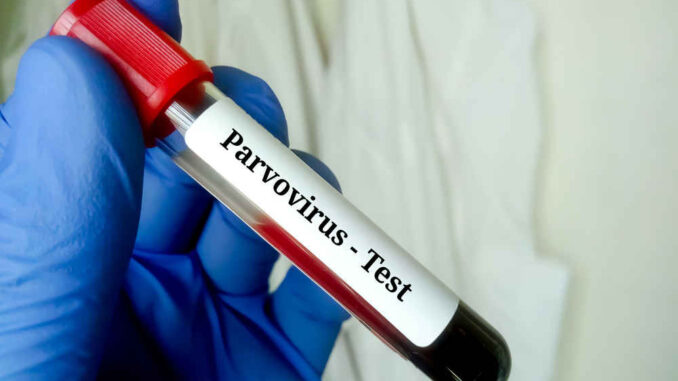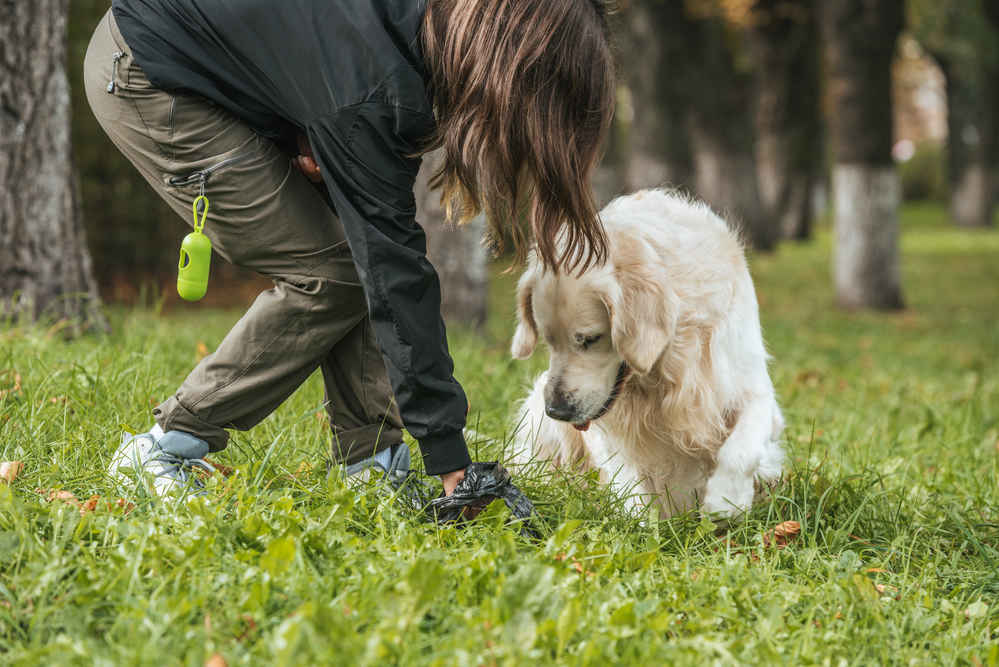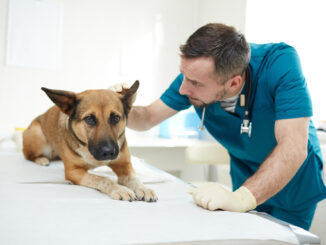
This article was updated on September 11th, 2022
There is a distinct metallic smell to dog feces / poop infected with parvovirus. The poop contains the shedded lining of the intestines and blood, which creates a horrible smell. Additionally, it can smell slightly sweet or rotten. The smell of Parvo poop is unique.
Why is there a Parvo smell?
As the virus reaches the bloodstream, it weakens the immune system by destroying bone marrow cells, allowing it to invade the gastrointestinal tract. The virus targets the epithelium in the small intestine, which allows the organ to absorb nutrients and is a barrier against invasion inside the body. This invasion doesn’t allow the intestines to absorb nutrients properly
Early stages of Parvo may not have any blood, or the smell. But as it progresses, the feces may be dark red or bright red. Dark red is digested blood coming from higher in the intestines. Bright red blood is undigested coming from lower in the intestines. This blood contributes significantly to the metallic smell of Parvo poop.
The most common symptoms of parvo include lethargy, depression, and lack of appetite. This is followed by a quick onset of high fever, vomiting, and diarrhea.
What is parvo?
Canine parvovirus “parvo” is a contagious virus in dogs that causes acute gastrointestinal illness. Parvo first emerged among dogs in Europe in 1976. Within two years, it spread unchecked throughout the population, creating issues in the intestines and heart. The current theory is the virus arose from mutations in Feline Panleukopenia Virus (FPV). Additionally, the illness can cause infections in wild canines or other wild animals.
Since the development of vaccines, the spread of parvo has decreased significantly. Puppies should complete a full set of parvo vaccines at eight, twelve, and sixteen weeks. Adult dogs should receive a parvovirus booster every one to three years.
It’s hard to pinpoint where your dog could get parvovirus. Puppies who are not fully vaccinated are more likely to get the illness. However, dogs who are immunocompromised or are subject to a large exposure can develop the illness. Not every dog who is exposed develops the illness.
What does Parvo poop look like?

Parvo poop is characterized by that distinct metallic smell. But it carries other characteristics you can use to identify it.
Parvo poop color can be brown, black, or almost red. Often, it will contain streaks of darker, older blood coming from higher in the intestine. Bright red blood is from the lower intestines. Additionally, Parvo poops sometimes have mucus which makes it appear thick and sticky.
How long does the smell last?
The infected dog will shed the Parvo particles in his feces before and after showing clinical signs. They can shed the virus particles for up to 6 weeks after recovery, which is how long the poop may smell.
While the smell may be more intense with higher amounts of particles in the poop, this is not an indicator of how severe your pet’s illness is. Every puppy with Parvo has a unique interaction with the disease.
Can dogs get parvo from smelling other dogs with parvo poop?
There are more factors for infection rather than exposure. However, parvo can live outdoors for up to a year. If your dog smells parvo poop, they could become infected.
I smell something metallic in my dog’s poop. What should I do?
If you’re smelling something metallic in your dog’s poop, it is likely Parvo.
Parvo most frequently affects puppies between six and twenty weeks, but it can infect older animals. Dogs who haven’t received their full range of vaccinations or have missed the booster are more likely to be infected with parvo. Puppies less than five months usually show the most severe symptoms and are the hardest to treat.
If you suspect Parvo, schedule an appointment with your veterinarian immediately.
How will my vet treat Parvo?
To diagnose your dog, the vet will conduct an inexpensive fecal test by doing a swab of the rectum. This is done to detect whether the area has been infected with the cells. Additionally, vets may recommend blood work to check for white blood cell levels or other issues. Dogs with parvo can be anemic due to blood loss or low sugar from the diarrhea or vomiting. There can be multiple causes for vomiting or diarrhea, so the vet may recommend x-rays or ultrasounds.
The treatment for parvo is more treatment than a cure. The vet will give IV fluids and electrolytes to keep your dog hydrated. Some vets give antibiotics to prevent secondary infections. Other medications may be given to relieve vomiting, nausea, and pain. De-wormer will be given since puppies usually have intestinal parasites which could worsen diarrhea.
Since the dog will not feel well enough to eat on their own, the vet will provide a temporary feeding tube to provide nutrients. Severe cases may need a plasma transfusion to help replenish the clotting factors and blood proteins the virus has attacked.
Will my dog survive parvo?
Survival can vary, but the most significant factor is the time before treatment. The survival rate of dogs treated by vets is 68 to 92 percent. A good indicator of a full recovery is whether the dog survives the first three to four days.
What can I do at home to treat parvo?
Ideally, a dog with parvo should be hospitalized to provide the best attention and care. However, outpatient treatment has been successful if there are financial issues. It is vital to ensure the owner gives medications on a rigorous schedule and to have daily checks with the vet to make sure the dog is progressing well. The survival rate for at-home care is 50 percent.
Some would recommend giving Parvaid to dogs infected with parvo. It boasts a 91 percent survival rate in unvaccinated dogs. Parvaid is an organic nutraceutical which is high in vitamin C. However, no rigorous research studies have been conducted to back these claims.
After your dog is infected, clean thoroughly. The virus can survive indoors for up to one month and can survive almost a year outside in the right conditions.
How do you get rid of the parvo smell?
The best method to kill parvovirus is a bleach solution. However, disinfection is harder on non-bleachable surfaces, such as the lawn or carpet. If there is good drainage outside, watering down the area may dilute the virus.
The Parvo smell is gone. Is my dog cured?
This could be a positive sign that shows recovery. However, it’s best to measure recovery based on whether your dog is vomiting, eating habits, and activity levels. Less or no blood in the stool can be a sign your dog is doing better.
Disclaimer: This website's content is not a substitute for veterinary care. Always consult with your veterinarian for healthcare decisions. Read More.



Be the first to comment